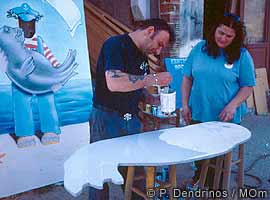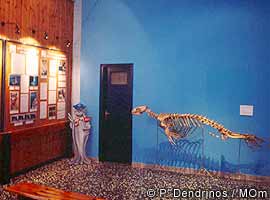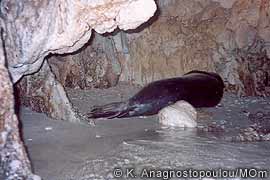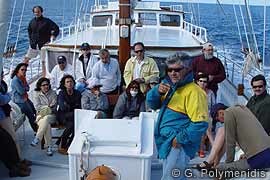

 |
||
 |
||
Vol. 6 (1): June 2003 |
Download this page
|
|
Bulgaria / Cyprus / Greece / Italy / Madeira / Mauritania and Western Sahara / Turkey
Bulgaria
Ropotamo Complex (formerly called ‘Arkoutino’). 24/09/1975. Burgas. 5,500 ha. 42°19'N 027°45'E. Partially Reserve, Natural Monument, Maintained Reserve and Protected Area. The site has been extended from 97 ha to 5,500 ha and the name has been changed on 24/09/2002. The site, on the southern Bulgarian Black Sea coast, represents a diverse mosaic of various habitats – river downstream and estuary, seasonally flooded riverine and broad-leaved deciduous forests, small freshwater and brackish lagoons, sand dunes, rocky shores and fjords, a sea bay, sea inlets. The site provides refuge to many nationally and internationally IUCN red-listed species of plants and animals, among which are seven globally threatened species of birds and two plant species, eight invertebrate species and seven mammal species. Rich endemic and relict flora and fauna are recorded in the site. The main human uses are forestry, hunting, and recreational activities, and the site is a very popular destination for nature lovers, offering some facilities as well. Management plans are in preparation, and the Bulgarian-Swiss Biodiversity Conservation Programme is active at the site. Ramsar site no. 65. The other very important site near Cape Kaliakra and Tjulenovo covers the criteria for Important Birds Area (for Phalacrocorax aristotelis) and will be included in the future Bulgarian Natura 2000 network. Unfortunately, monk seals have already been exterminated in Bulgaria. – Stefan Avramov, Bulgarian Society for the Protection of Birds/BirdLife Bulgaria.
|
||||||||||||
 |
 |
|
|
MOm's Visitor Centre on Alonissos, in the Northern Sporades Marine Park, has recently been reopened after renovation and renwal of exhibits. The Centre is the only source of public information on the monk seal in the NMPANS. |
||
Environmental NGOs within Greece, including MOm, have been striving for improved ties and inter-organisational cooperation. Ad hoc meetings held over the last year have attempted to forge a common policy with regard to the management of protected areas, and NGO participation within the process.
The Natura 2000 Committee was subsequently formed at the beginning of 2003, a new institutional instrument with consultative status towards the Ministry of Environment. The Committee has a mandate to monitor and coordinate actions that are being carried out in all of Greece’s Natura 2000 protected areas, and will evaluate the implementation of relevant EU legislation.
Dr. Spyros Kotomatas, MOm’s scientific coordinator, represents MOm in the Natura 2000 Committee. – MOm.
MOm’s creation of permanent field teams in Kimolos-Polyaigos in the Cyclades islands and Karpathos-Saria in the eastern Aegean, has allowed the organisation to conduct a more detailed and systematic study of local monk seal populations and their biotopes.
 |
|
|
Kimolos seal |
The research forms part of MOm’s EU-funded LIFE programme to establish marine reserves in the two areas [see LIFE funding for Natura 2000 areas, TMG 4 (2): November 2001].
During 2002, special emphasis was placed on detailed monitoring of the use of caves by the seals, and the recording of births during the reproduction period.
As far as Kimolos-Polyegos is concerned, analysis of the collected data confirms the area’s significance for the protection of the species on an international basis. Indeed, the total of 17 newborn seals recorded in the area over the past two years (9 during 2001 and 8 in 2002) represents the second highest number of births recorded during the same period in any geographical area of the Mediterranean.
As far as Northern Karpathos-Saria is concerned, findings to date suggest that this area is also important for the species, as evidenced by the 8 newborn seals recorded during the past two years (3 during 2001 and 5 in 2002). – Stella Adamantopoulou and Spiros Kotomatas, MOm.
Meanwhile, drawing on its long-running experience within the NMPANS between 1990 and 2002, MOm launched a pilot surveillance system for Kimolos-Polyaigos and Karpathos-Saria, tailored to the particular needs of each area. This involved:
The pilot surveillance scheme will continue to operate until 2004, hopefully providing invaluable practical experience for the management authorities that will eventually be responsible for guarding activities in each area. – Stella Adamantopoulou and Spiros Kotomatas, MOm.
Uncertainty in Kimolos, TMG 5 (2): November 2002
For a month leading up to Christmas 2002, MOm’s new public service announcement on the plight of the monk seal was broadcast by TV stations across Greece. As far as concept was concerned, the idea behind the 2002 ad was innovative, focusing on conservation actions undertaken by MOm in the Northern Sporades Marine Park, Kimolos and Karpathos.
The ad was broadcast on E.T. 1, N.E.T., ALPHA TV, ANTENNA TV, MEGA CHANNEL, STAR CHANNEL (Athens), E.T. 3 (Thessaloniki), TV IRIDA, RADIO-TV COSMOS, RHODES CHANNEL (Dodecanese), AEGEAN TV, SYROS TV (Cyclades) and T.R.T. (Thessaly).
Underlining their continuing support for MOm’s conservation efforts, Adel Saatchi & Saatchi provided their creative and conceptual advertising skills free-of-charge. Anna Maria Harokopou and the company Filmiki Etairia also made a substantial contribution in terms of studio work. – MOm.
MOm’s research team has released the final pup tally for monk seal births recorded during the 2002-2003 season in the organisation’s three main study areas:
Nine newborn seals were recorded in the core zone of the National Marine Park of Alonissos-Northern Sporades, 8 in the Kimolos-Polyaigos area and 5 in the area of N. Karpathos-Saria. – Panos Dendrinos, MOm.
 |
|
|
MOm’s Panos Dendrinos guiding Workshop participants through the NMPANS |
Following the success of the “Forest Workshop” at Evros in 2002, this year WWF Greece and MOm joined forces to host a similar “Marine Workshop” on Alonissos in the Northern Sporades Marine Park. The Workshop took place from 23 – 30 of May, at the Biological Research Station at Gerakas.
The principal aims of the Workshop were to contribute to the sound management of Greece’s fragile marine and coastal ecosystems by offering personnel from public and private entities both theoretical and practical knowledge relating to the administration of marine protected areas. Participants benefited from experience gained by WWF Greece in various projects around the country, and from MOm’s multi-year experience in the management of Greece’s first National Marine Park.
Aside from theoretical lectures by WWF and MOm specialists, individual and group training projects took place both in the field and in class. Topics ranged from legal and institutional aspects of marine protected areas to addressing day-to-day management problems, ecosystem monitoring, the participation of local communities in the conservation process, and the possibilities of developing sustainable ecotourism activities within protected areas. – Vrassidas Zavras, MOm.
Mediterranean News continues with Italy, Madeira, Mauritania & Western Sahara, and Turkey...
Copyright © 2003 The Monachus Guardian. All Rights Reserved |